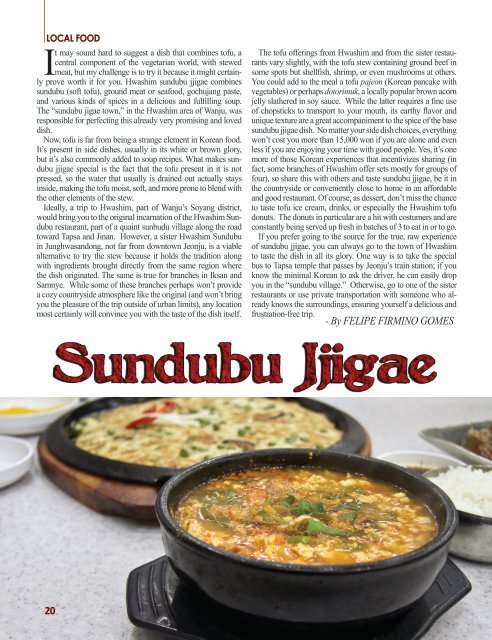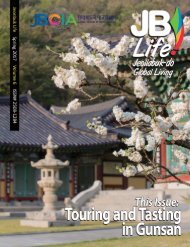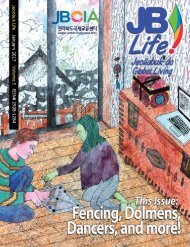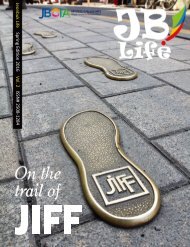JB Life Summer Vol. 3
The summer issue of JB Life, Jeollbauk-do's English magazine, covering July-September.
The summer issue of JB Life, Jeollbauk-do's English magazine, covering July-September.
Create successful ePaper yourself
Turn your PDF publications into a flip-book with our unique Google optimized e-Paper software.
LOCAL FOOD<br />
It may sound hard to suggest a dish that combines tofu, a<br />
central component of the vegetarian world, with stewed<br />
meat, but my challenge is to try it because it might certainly<br />
prove worth it for you. Hwashim sundubu jjigae combines<br />
sundubu (soft tofu), ground meat or seafood, gochujang paste,<br />
and various kinds of spices in a delicious and fulfilling soup.<br />
The “sundubu jigae town,” in the Hwashim area of Wanju, was<br />
responsible for perfecting this already very promising and loved<br />
dish.<br />
Now, tofu is far from being a strange element in Korean food.<br />
It’s present in side dishes, usually in its white or brown glory,<br />
but it’s also commonly added to soup recipes. What makes sundubu<br />
jjigae special is the fact that the tofu present in it is not<br />
pressed, so the water that usually is drained out actually stays<br />
inside, making the tofu moist, soft, and more prone to blend with<br />
the other elements of the stew.<br />
Ideally, a trip to Hwashim, part of Wanju’s Soyang district,<br />
would bring you to the original incarnation of the Hwashim Sundubu<br />
restaurant, part of a quaint sunbudu village along the road<br />
toward Tapsa and Jinan. However, a sister Hwashim Sundubu<br />
in Junghwasandong, not far from downtown Jeonju, is a viable<br />
alternative to try the stew because it holds the tradition along<br />
with ingredients brought directly from the same region where<br />
the dish originated. The same is true for branches in Iksan and<br />
Samnye. While some of these branches perhaps won’t provide<br />
a cozy countryside atmosphere like the original (and won’t bring<br />
you the pleasure of the trip outside of urban limits), any location<br />
most certainly will convince you with the taste of the dish itself.<br />
The tofu offerings from Hwashim and from the sister restaurants<br />
vary slightly, with the tofu stew containing ground beef in<br />
some spots but shellfish, shrimp, or even mushrooms at others.<br />
You could add to the meal a tofu pajeon (Korean pancake with<br />
vegetables) or perhaps dotorimuk, a locally popular brown acorn<br />
jelly slathered in soy sauce. While the latter requires a fine use<br />
of chopsticks to transport to your mouth, its earthy flavor and<br />
unique texture are a great accompaniment to the spice of the base<br />
sundubu jjigae dish. No matter your side dish choices, everything<br />
won’t cost you more than 15,000 won if you are alone and even<br />
less if you are enjoying your time with good people. Yes, it’s one<br />
more of those Korean experiences that incentivizes sharing (in<br />
fact, some branches of Hwashim offer sets mostly for groups of<br />
four), so share this with others and taste sundubu jjigae, be it in<br />
the countryside or conveniently close to home in an affordable<br />
and good restaurant. Of course, as dessert, don’t miss the chance<br />
to taste tofu ice cream, drinks, or especially the Hwashim tofu<br />
donuts. The donuts in particular are a hit with costumers and are<br />
constantly being served up fresh in batches of 3 to eat in or to go.<br />
If you prefer going to the source for the true, raw experience<br />
of sundubu jjigae, you can always go to the town of Hwashim<br />
to taste the dish in all its glory. One way is to take the special<br />
bus to Tapsa temple that passes by Jeonju’s train station; if you<br />
know the minimal Korean to ask the driver, he can easily drop<br />
you in the “sundubu village.” Otherwise, go to one of the sister<br />
restaurants or use private transportation with someone who already<br />
knows the surroundings, ensuring yourself a delicious and<br />
frustration-free trip.<br />
- By FELIPE FIRMINO GOMES<br />
By FELIPE FIRMINO GOMES<br />
Jeonbuk <strong>Life</strong> Contributing Writer<br />
Cham bungeojim is a dish born in Hwasan, in Wanju,<br />
and it’s one of the most characteristic dishes in<br />
that area. It’s composed of freshwater fish (typically<br />
carp, usually served inside a type of metal pan), leafy vegetables<br />
(similar to spicier types of kimchi) and several types of<br />
side dishes (radish leaf and acorn tofu are common accompaniments).<br />
The presentation itself is certainly something to behold. The<br />
fish is big (around 30 centimeters usually) and the spices used<br />
on the outside, combined with the broth inside the pan, make for<br />
a very visual experience. At this point, with your food staring<br />
back at you, you will probably think to yourself, “This might be<br />
a bigger challenge than I was anticipating,” but this is also part<br />
of the package. The fish is kept mostly intact so you can take<br />
your time enjoying all its parts in whichever order you prefer.<br />
The fish itself is very flavorful and unique. There is something<br />
special about the way it is salted: radish leaves are added<br />
to it to accentuate the features (and you can also eat those<br />
leaves, if you don’t mind the fact that they will be also drenched<br />
in heavy spices). If you like to savor the different parts of any<br />
fish, prepare to be surprised even then. It wouldn’t be hard to<br />
find clumps of small fish eggs inside at least one of the usually<br />
two fish served in the portion. It certainly adds an unexpected<br />
element, and a type of flavor and texture that will leave you<br />
wondering about how it was prepared. The fish is loaded with<br />
spices and condiments that act differently in each part of the<br />
fish: the more tender parts tend to suck in more of those, which<br />
grants a stronger and more pronounced flavor.<br />
The dish will cost you around 15,000 won for a serving that<br />
is really plentiful for two people. Personally, I recommend it<br />
as a dinner dish accompanied by makgeolli or soju. And save<br />
some space in your stomach for a treat in the end. It’s normal<br />
for a restaurant to cap off the experience by preparing you some<br />
nurungji, or scorched rice drink, a very old Korean recipe that<br />
consists basically of adding hot water to the remaining rice inside<br />
a pan. After a while, the rice gets a moist consistency, very<br />
pleasant after what can be considered a quite substantial meal.<br />
This dish was created in the same county where the sundubu<br />
jjigae formula was perfected (Wanju), and it would be safe to<br />
assume all the ingredients to not only be very natural in their<br />
composition, but also come from local crops. Even though it<br />
might be a little hard to get to Hwasan, the small town where<br />
the dish comes from, local options can be found for very decent<br />
prices. In the Jeonju neighborhood of Ajungli, very close<br />
to the now-defunct Ajungli train station, a very handy alternative<br />
is present. The Jeonju restaurant – very plainly named<br />
Hwasan Cham Bungeochim, offers a very similar experience<br />
to the source. The tradition of ingredients, preparation method<br />
and serving are kept close to what they are in Hwasan, near<br />
the Gyeongcheon Reservoir, where many restaurants offering<br />
the original dish lie. Still, if you feel like adventuring, three of<br />
the most famous and original cham bungeojim experiences can<br />
be found around the reservoir in Hwasan: Hwasan Shikdang,<br />
Sansujang Garden, and Yaksu Garden are three representative<br />
restaurants. And keep in mind -- It is said that this dish is best<br />
experienced with scenery as a side dish, so taking a trip to eat it<br />
at the reservoir in Hwasan is definitely preferred.<br />
20 Jeonbuk <strong>Life</strong> 21







